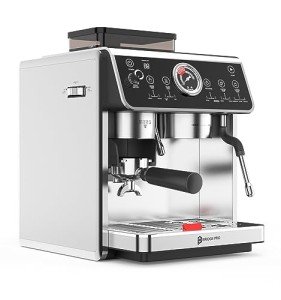The Art of Italian Espresso Machines: A Brewed Tradition
Italian espresso machines are not just appliances; they are an essential part of Italy's abundant coffee culture, representing a blend of artistry, engineering, and style. Coffee aficionados around the globe recognize the importance of high-quality espresso, a staple of Italian life and food. This article checks out the history, mechanics, types, and aspects to consider when purchasing an Italian espresso machine, reflecting the depth of this cherished drink and its developing methods.
History of Espresso Machines
The espresso machine's development go back to the early 20th century in Italy, where coffee was not merely a drink but an essential social routine. The initial attempts to brew espresso begun with basic, stove-top models, gradually progressing into intricate machines that might reproduce the perfect brew.
- 1901-- The First Espresso Machine: The very first steam-powered espresso machine, called the "Ideale," was developed by Luigi Bezzera. Best Budget Espresso Machines marked a turning point in espresso brewing.
- 1938-- The Lever Machine: The introduction of the lever machine made it easier to control the pressure utilized in espresso extraction, enhancing taste consistency.
- 1947-- The Automatic Machine: Reaching more consumers, Gaggia launched the very first automatic espresso machine, further promoting espresso bars.
- 2007-- The Digital Age: Technological improvements resulted in the birth of completely programmable machines, allowing users to tailor their developing settings to attain a tailored coffee experience.
Key Features of Italian Espresso Machines
Italian espresso machines embody accuracy, craftsmanship, and innovation. Here are some key components that highlight their significance:
| Feature | Description |
|---|---|
| Boiler Type | Figures out how heat is generated and preserved. Common types include single boiler, dual boiler, and heat exchanger. |
| Group Heads | Where the coffee is brewed; commercial machines typically have several group heads for efficiency. |
| Pressure Control | Vital for achieving the best espresso; most machines run at 9 bars of pressure. |
| Frothing Capabilities | The steam wand permits milk frothing, essential for drinks like cappuccino and latte. |
| Build Quality | The products used (stainless steel, brass, etc) influence toughness and heat retention. |
Kinds Of Italian Espresso Machines
Picking the best machine hinges on user choices, budget, and meant use. Below are the primary kinds of Italian espresso machines:
Manual Espresso Machines
- Pros: Offer full control over the brewing procedure, enabling an individualized touch.
- Cons: Require ability and practice, can be labor-intensive.
Semi-Automatic Machines
- Pros: Provide a balance in between automatic and manual processes; users manage water flow.
- Cons: Can have a steeper knowing curve than fully automatic machines.
Totally Automatic Machines
- Pros: Simplify the brewing procedure with push-button operations; ideal for newbies.
- Cons: May compromise some of the nuances of manual developing.
Super-Automatic Machines
- Pros: Grind, tamp, brew, and froth immediately; convenient for busy way of lives.
- Cons: Less control over the brewing variables, potential for a less genuine espresso experience.
Purchasing Guide: Factors to Consider
Choosing the perfect Italian espresso machine can be overwhelming, but thinking about the following aspects can streamline the decision-making process:
- Budget: Italian espresso machines range from affordable to high-end designs, so set a budget upfront.
- Use Frequency: Evaluate how typically you will use the machine; day-to-day users may desire a more resilient choice.
- Area: Measure your kitchen area or counter area; some machines can be big and require adequate clearance.
- Maintenance: Consider ease of cleansing; machines with removable parts or built-in cleansing features might reduce upkeep.
- User Skill Level: Beginners may prefer completely or semi-automatic machines, while skilled baristas can manage manual machines.
- Brand name Reputation: Research brand names known for quality, such as Breville, Gaggia, and La Marzocco.
Popular Italian Espresso Machine Brands
Italian craftsmanship is renowned for producing a few of the very best espresso machines worldwide. Here are top brand names worth considering:
- Gaggia: Known for its home espresso machines and price.
- La Marzocco: An exceptional brand name known for its commercial-grade machines and ingenious technology.
- Rancilio: Renowned for its durable develop and professional-quality machines suitable for home and commercial use.
- Sage/Breville: Offers advanced features and easy to use styles, perfect for both novices and lovers.
Frequently asked questions
What is the distinction in between espresso and routine coffee?
Espresso is a focused coffee brewed by forcing warm water through finely-ground coffee under pressure. It has a thicker consistency, richer taste, and greater caffeine concentration than regular coffee.
Can I make milk-based beverages with an espresso machine?
Yes, lots of Italian espresso machines come with a steam wand to froth milk for beverages like cappuccinos, lattes, and macchiatos.
How frequently should I clean my espresso machine?
Regular upkeep is necessary. Typically, a comprehensive cleansing is recommended every few weeks, while descaling needs to be done every 1 to 3 months, depending on water solidity.
What is the ideal pressure for developing espresso?
The perfect pressure for brewing espresso is around 9 bars. This pressure guarantees the optimal extraction of flavors from the coffee premises.
Are more expensive machines worth the financial investment?
Higher-end machines frequently make use of better products and technology, supplying enhanced durability and more consistent results. For serious coffee enthusiasts, purchasing a good machine can elevate the espresso experience considerably.
Italian espresso machines are far more than simple developing devices; they are a celebration of a cultural custom that has actually influenced coffee usage worldwide. With various models available to fit any user's needs-- ranging from beginners to experienced baristas-- there is an Italian espresso machine perfectly matched for everybody. As you embark on your espresso journey, understanding the history, mechanics, and options will enhance your experience and gratitude for this time-honored beverage. Whether you look for to recreate a coffee shop ambiance in your home or improve your brewing strategy, these machines are capable of providing extraordinary cups of espresso decorated with the abundant history of Italian coffee culture.

